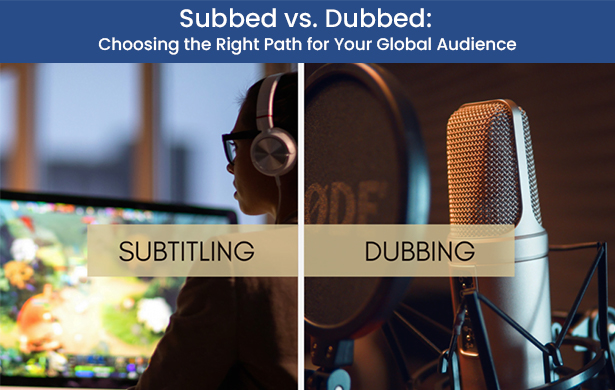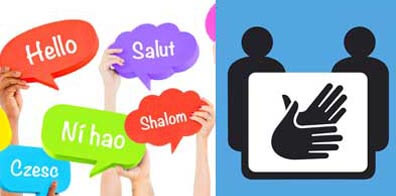
In the world of entertainment, be it national or international, one of the most crucial decisions content creators and distributors face is whether to subtitle or dub their media when targeting global audiences. While both options aim to make audiovisual content accessible to viewers who speak different languages, they offer distinct experiences and present new challenges. The choice between subbed (subtitled) and dubbed (voice-over) content is often influenced by cultural preferences, the type of content, and the specific market in question.
In this blog post, we’ll explore the differences between subbed and dubbed content, the advantages and disadvantages of each, and how to choose the right audiovisual translation service for your global audience. Sounds interesting? Let’s get started!
Before getting into the debate, let’s clarify the terms:
Subbed: Subtitles are textual translations of the spoken dialogue in a film or TV show, usually displayed at the bottom of the screen. Viewers still hear the original audio (in the source language) while reading the translation (in the target language).
Dubbed:This involves replacing the original voice with new ones speaking in the target language. The original audio is either muted or replaced, and the new dialogue is synchronised to match the lip movements of the characters.
Now that we’ve defined the two, let’s examine the factors that influence the decision to subtitle or dub your audiovisual content.
One of the main factors driving the decision between subbed or dubbed content is cultural preference. Different countries have different attitudes towards subtitles and dubbing, and understanding these preferences is key to ensuring the success of your content.
In many parts of Europe, particularly in Scandinavia, the Netherlands, and Germany, subtitled content is widely preferred. Audiences in these regions are accustomed to watching foreign films and TV shows with subtitles and often find them more authentic. Subtitles allow viewers to hear the original voice acting, which is considered integral to experiencing the content as it was intended.
In Asia, countries such as Japan and South Korea also favour subtitles, particularly when it comes to animated films and TV series (anime and K-dramas). Subbed content offers an unaltered experience, allowing audiences to appreciate the original nuances and emotions conveyed by the voice actors.
In contrast, dubbing is the preferred method of content localisation in many Latin American and European countries, such as Spain and Italy, where audiences tend to be less familiar with reading subtitles. Dubbing is also very popular for children’s television, where young viewers may struggle to read subtitles quickly enough.
For countries such as the United States, the United Kingdom, and parts of Eastern Europe, the decision between dubbed and subbed often depends on the genre and the target demographic.
The choice between subbed and dubbed content can significantly affect the viewer’s experience. Let’s explore how each option impacts the way audiences engage with the media.
One of the key advantages of subtitled content is that it preserves the integrity of the original performance. The viewer hears the actors’ voices, which often convey subtle emotions, inflections, and cultural nuances that might not be fully captured in a dubbed version. For many, hearing the original voice acting is an integral part of the authentic experience.
However, subtitles can be a distraction for some viewers. Reading subtitles while watching action sequences or fast-moving dialogue may lead to missing out on visual elements.
On the other hand, dubbing simply offers a more seamless viewing experience, especially for those who are not accustomed to reading subtitles. This is particularly beneficial for those who want to focus entirely on the visuals and avoid reading text while watching the content. Dubbing is also an excellent option for younger audiences or individuals with reading disabilities, as it makes the content more accessible.
However, dubbing does come with its own set of challenges. One major issue is that dubbing can lose the emotional depth and authenticity of the original performance. The voice actors in the dubbed version may not match the tone or delivery of the original, which can lead to a disconnection for viewers familiar with the source material. Lip-syncing can be a complex task, and sometimes the dubbed lines don’t quite match the movements of the characters’ mouths, which can be distracting.
The production process for both subbed and dubbed content varies in terms of time, effort, and costs.
Subtitles are typically quicker and more cost-effective to produce than dubbing. Translators work directly from the script and can produce subtitles faster than dubbing a whole track with professional voice actors. The process of syncing subtitles to the video is relatively straightforward compared to the technical complexities of dubbing.
For businesses and content creators working on a tight budget or deadline, subtitling is often the more practical solution. It allows for a quicker turnaround time, especially when targeting multiple languages.
While often preferred for certain regions and demographics, dubbing is more time-consuming and expensive. It involves casting voice actors, recording and synchronising dialogue, and ensuring that the new track matches the original video’s lip movements. Moreover, dubbing requires additional post-production work to make sure the final product sounds natural in the target language.
For content creators looking to invest in the best possible experience for their audience, dubbing might be the right choice. However, for those with budget constraints or tight schedules, subtitling is often the go-to solution.
Choosing the right audiovisual translation service is essential, but it’s equally important to ensure it aligns with your audience’s needs and preferences. When deciding between subbed and dubbed content for a global audience, consider the following factors:
What is the demographic of your audience? Are they accustomed to reading subtitles, or would they prefer the convenience of dubbed content? This is especially important for children’s programming and fast-paced genres such as action films.
Some languages and cultures may have specific expectations when it comes to the viewing experience. Research your target market thoroughly to ensure that the chosen method aligns with their preferences.
If you’re on a tight budget or timeline, subtitling may be a more cost-effective and efficient choice. Dubbing is ideal when there is more flexibility in the production process.
The genre and nature of the content also play a role. For animated films, children’s TV, or comedy content, dubbing might be preferred. However, for drama, art films, and content where the actor’s original voice is key, subtitling is preferably the better option.
Whether you choose to subtitle or dub your audiovisual content, the most important thing is that your decision aligns with the preferences and expectations of your target audience. Both options have their benefits and drawbacks, and in some cases, the best solution may be to offer both—subtitles for those who prefer an authentic experience and dubbing for those who want convenience.
At Language Services Bureau, we specialise in professional audiovisual translation services, helping you bring your content to audiences worldwide with precision and cultural sensitivity. Whether you need high-quality subtitles or expert dubbing, our team is here to support your global outreach.
Let us help you tackle the complexities of language and culture so you can connect with audiences around the world.
Learn how our audiovisual translation services can boost your global content strategy by contacting us today!
For any queries related to language translation services. Inquire at our email address below or give us a call today!
info@languageservicesbureau.com
Telephone: +91-20-24470509, +91-82370 60559
Similar articles for you...

आमच्या गेल्या महिन्यातील ब्लॉग मध्ये भाषांचे ज्ञान आवश्यक असणाऱ्या करियर क्षेत्रांची माहिती आपल्याला मिळाली. जिथे भाषेचे ज्ञान फायद्याचे ठरते असे इतर व्यवसाय आपण या महिन्यात पाहुयात.

Posted by : Language Services Bureau

The time it takes to learn a language depends on what you want to do with it– here is a great article about language learning and the kind of expectations you can set about the time required for the same!